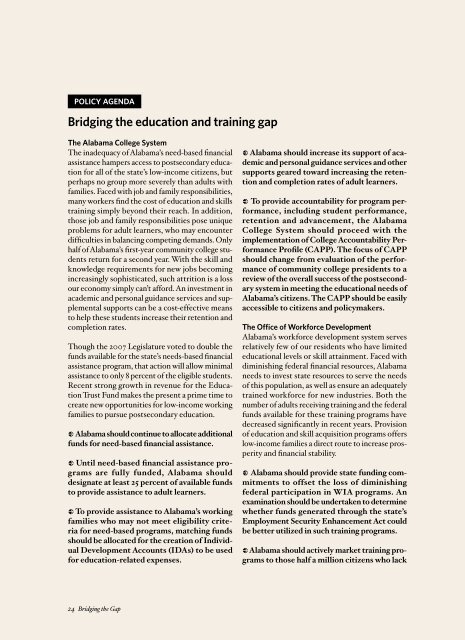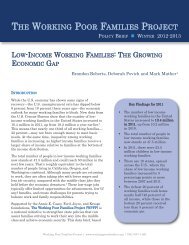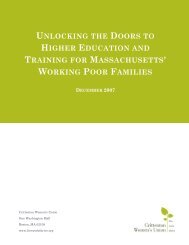alabama's working families and the broken promise of economic ...
alabama's working families and the broken promise of economic ...
alabama's working families and the broken promise of economic ...
- No tags were found...
You also want an ePaper? Increase the reach of your titles
YUMPU automatically turns print PDFs into web optimized ePapers that Google loves.
POLICY AGENDABridging <strong>the</strong> education <strong>and</strong> training gapThe Alabama College SystemThe inadequacy <strong>of</strong> Alabama’s need-based financialassistance hampers access to postsecondary educationfor all <strong>of</strong> <strong>the</strong> state’s low-income citizens, butperhaps no group more severely than adults with<strong>families</strong>. Faced with job <strong>and</strong> family responsibilities,many workers find <strong>the</strong> cost <strong>of</strong> education <strong>and</strong> skillstraining simply beyond <strong>the</strong>ir reach. In addition,those job <strong>and</strong> family responsibilities pose uniqueproblems for adult learners, who may encounterdifficulties in balancing competing dem<strong>and</strong>s. Onlyhalf <strong>of</strong> Alabama’s first-year community college studentsreturn for a second year. With <strong>the</strong> skill <strong>and</strong>knowledge requirements for new jobs becomingincreasingly sophisticated, such attrition is a lossour economy simply can’t afford. An investment inacademic <strong>and</strong> personal guidance services <strong>and</strong> supplementalsupports can be a cost-effective meansto help <strong>the</strong>se students increase <strong>the</strong>ir retention <strong>and</strong>completion rates.Though <strong>the</strong> 2007 Legislature voted to double <strong>the</strong>funds available for <strong>the</strong> state’s needs-based financialassistance program, that action will allow minimalassistance to only 8 percent <strong>of</strong> <strong>the</strong> eligible students.Recent strong growth in revenue for <strong>the</strong> EducationTrust Fund makes <strong>the</strong> present a prime time tocreate new opportunities for low-income <strong>working</strong><strong>families</strong> to pursue postsecondary education.[ Alabama should continue to allocate additionalfunds for need-based financial assistance.[ Until need-based financial assistance programsare fully funded, Alabama shoulddesignate at least 25 percent <strong>of</strong> available fundsto provide assistance to adult learners.[ To provide assistance to Alabama’s <strong>working</strong><strong>families</strong> who may not meet eligibility criteriafor need-based programs, matching fundsshould be allocated for <strong>the</strong> creation <strong>of</strong> IndividualDevelopment Accounts (IDAs) to be usedfor education-related expenses.[ Alabama should increase its support <strong>of</strong> academic<strong>and</strong> personal guidance services <strong>and</strong> o<strong>the</strong>rsupports geared toward increasing <strong>the</strong> retention<strong>and</strong> completion rates <strong>of</strong> adult learners.[ To provide accountability for program performance,including student performance,retention <strong>and</strong> advancement, <strong>the</strong> AlabamaCollege System should proceed with <strong>the</strong>implementation <strong>of</strong> College Accountability PerformancePr<strong>of</strong>ile (CAPP). The focus <strong>of</strong> CAPPshould change from evaluation <strong>of</strong> <strong>the</strong> performance<strong>of</strong> community college presidents to areview <strong>of</strong> <strong>the</strong> overall success <strong>of</strong> <strong>the</strong> postsecondarysystem in meeting <strong>the</strong> educational needs <strong>of</strong>Alabama’s citizens. The CAPP should be easilyaccessible to citizens <strong>and</strong> policymakers.The Office <strong>of</strong> Workforce DevelopmentAlabama’s workforce development system servesrelatively few <strong>of</strong> our residents who have limitededucational levels or skill attainment. Faced withdiminishing federal financial resources, Alabamaneeds to invest state resources to serve <strong>the</strong> needs<strong>of</strong> this population, as well as ensure an adequatelytrained workforce for new industries. Both <strong>the</strong>number <strong>of</strong> adults receiving training <strong>and</strong> <strong>the</strong> federalfunds available for <strong>the</strong>se training programs havedecreased significantly in recent years. Provision<strong>of</strong> education <strong>and</strong> skill acquisition programs <strong>of</strong>ferslow-income <strong>families</strong> a direct route to increase prosperity<strong>and</strong> financial stability.[ Alabama should provide state funding commitmentsto <strong>of</strong>fset <strong>the</strong> loss <strong>of</strong> diminishingfederal participation in WIA programs. Anexamination should be undertaken to determinewhe<strong>the</strong>r funds generated through <strong>the</strong> state’sEmployment Security Enhancement Act couldbe better utilized in such training programs.[ Alabama should actively market training programsto those half a million citizens who lack24 Bridging <strong>the</strong> Gap







